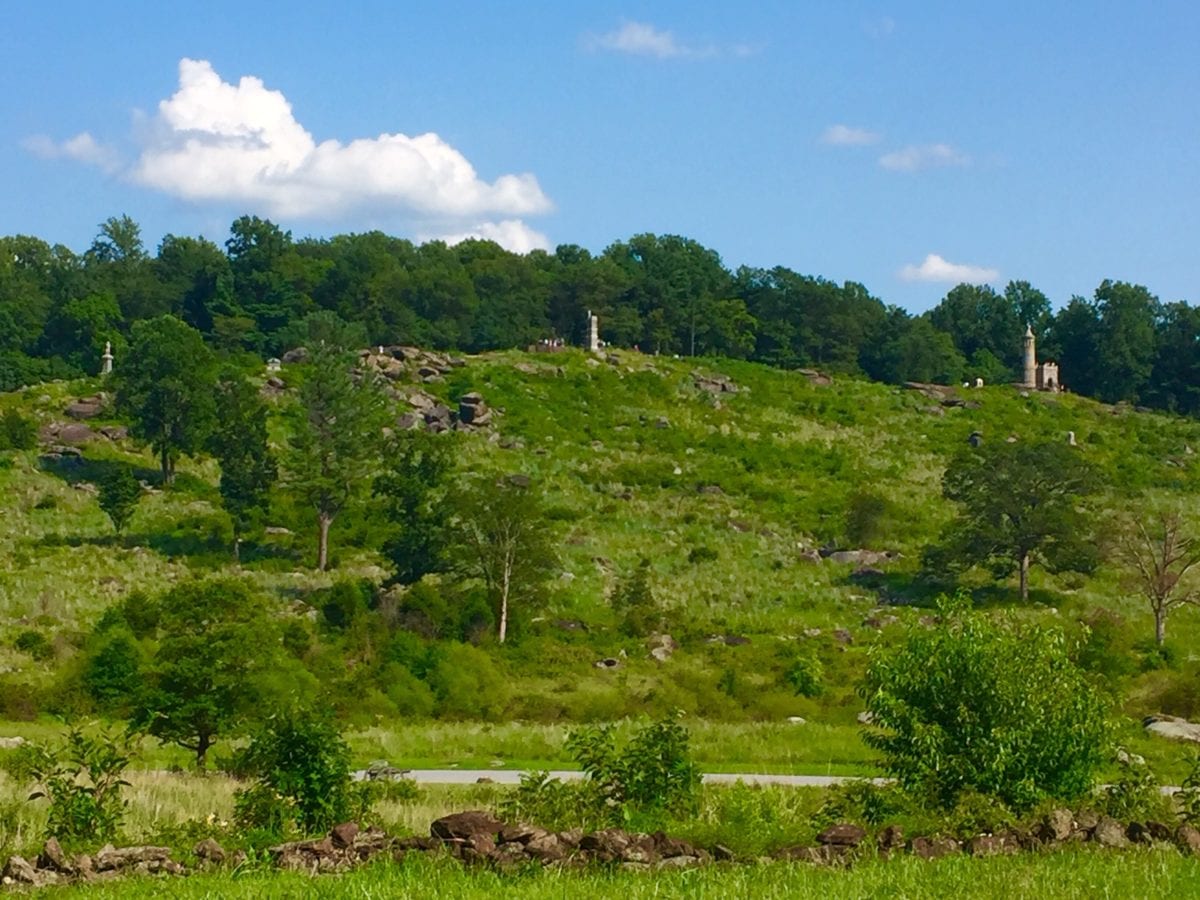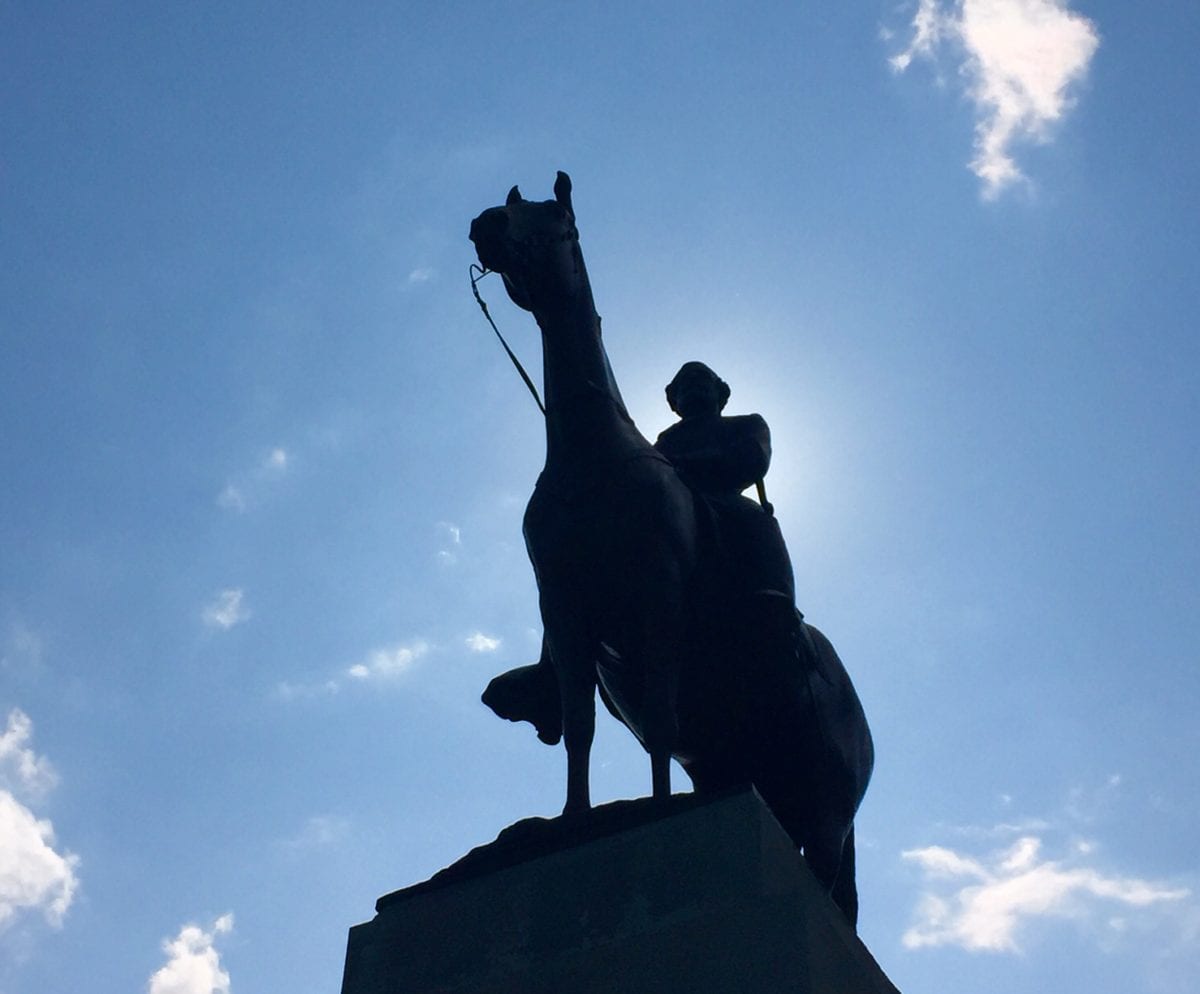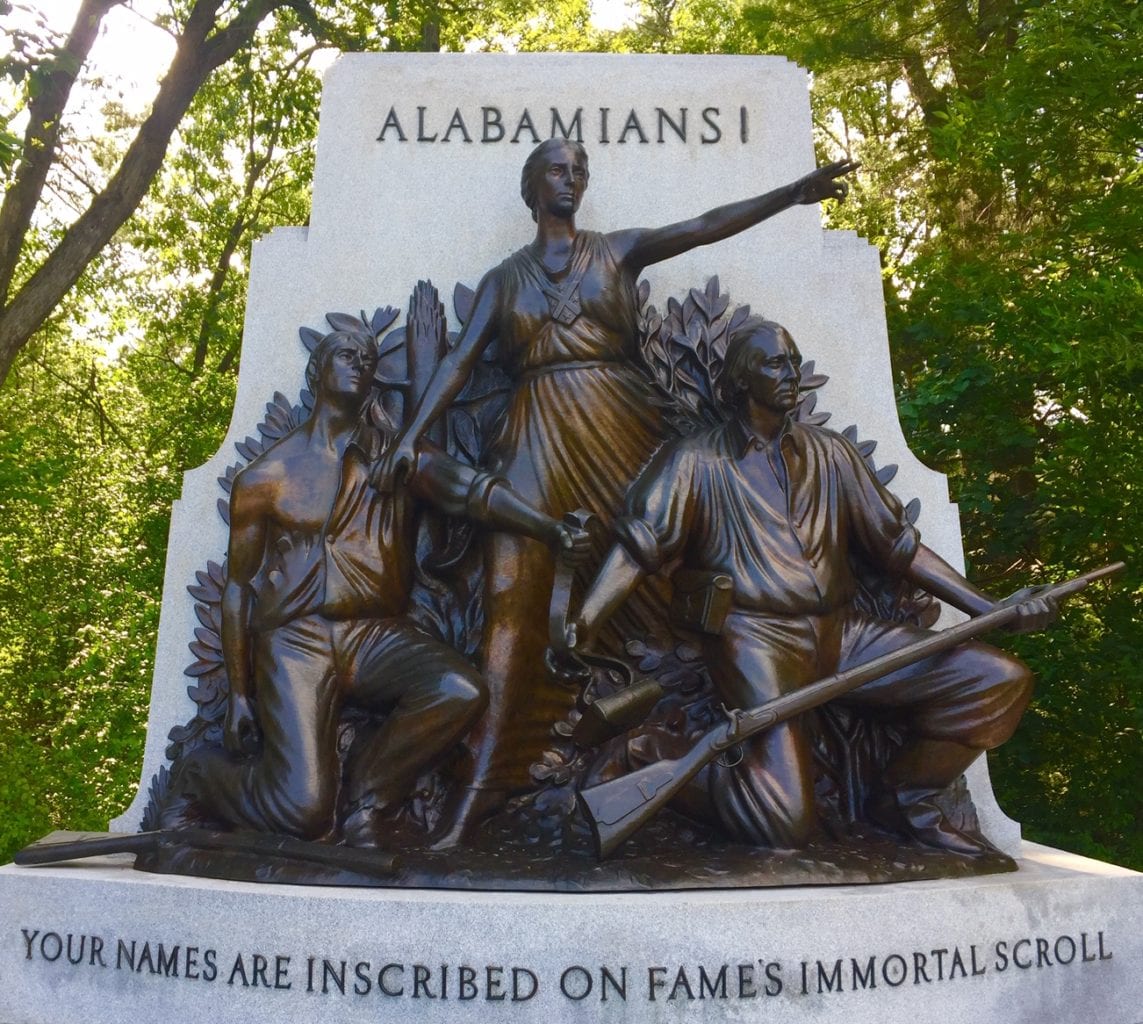The Big Picture –
By Glynn Wilson –
GETTYSBURG, Pa. — They say if you listen close enough at night by the creeks in these parts, you can still hear the cries of some of the ghosts of the 51,000 soldiers who bled and died here in the effort to save or break up the United States of America in the summer of 1863.
All I heard in the babbling brook by our campsite, however, was a faint whooping call of “yee-haw” by the “wild boys” of the Alabama 15th Regiment, otherwise known as the “rebel yell.” They wore a yellow patch on their Confederate grey uniforms. The Yankees called them Yellowhammers after the state bird of Alabama, the yellow-shafted flicker woodpecker.
The sound was in the imagination of my ears, of course. While historians may debate what the yell sounded like, Google it, I already know. I heard it many times in my undergraduate days at Alabama football games during the time of Bear Bryant and George Wallace, fueled by the courage of Jack Daniels whiskey.
I had never toured the Gettysburg National Military Park before, in part because I prefer other national parks not so connected to the Civil War. But everybody told me I had to do it, to go there once to see it for myself. So I did.
According to the National Park Service version of the story, the Battle of Gettysburg was a turning point in the Civil War, the Union victory that ended General Robert E. Lee’s second and most ambitious invasion of the North. Often referred to as the “High Water Mark of the Rebellion,” Gettysburg was the Civil War’s bloodiest battle, also the inspiration for President Abraham Lincoln’s immortal “Gettysburg Address.”
I stood on the hallowed ground where Lincoln delivered that historic short speech, just 271 words, beginning with the now iconic phrase, “Four score and seven years ago,” referring to the signing of the Declaration of Independence 87 years earlier. Lincoln described the U.S. as a nation “conceived in Liberty, and dedicated to the proposition that all men are created equal,” and represented the Civil War as a test that would determine whether such a nation, sundered by the secession crisis, could endure. He extolled the sacrifices of those who died at Gettysburg in defense of those principles, and exhorted his listeners to resolve:
“… that these dead shall not have died in vain — that this nation, under God, shall have a new birth of freedom — and that government of the people, by the people, for the people, shall not perish from the earth.”
Of course it is an interesting contradiction, sitting here in a barbecue joint in Carlisle now, home of the liberal arts Dickenson College, that rebel flag defenders also claim to be the most patriotic Americans.
Talking to a conservative friend in North Carolina a few weeks back, it came up in conversation that if the South had won the Civil War, there would be no great United States of America today. We would have ended up as two warring nations, one with slavery, one without. It could not have lasted. There would have been another war, and another.
“What does that have to do with anything?” my friend rejoined.
“Pretty much everything,” I said.
Here’s a patriotic American veteran of the Vietnam era who literally stands up and salutes the American flag on the TV whenever PBS runs a special on Memorial Day, Veterans Day or the Fourth of July. Yet he will also defend to the death the flying of the Confederate Battle Flag and the lost but “worthy” cause it’s supposed to represent for those who still fly it.
This is one reason Trump won the election of 2016. Exploiting this contradiction in thinking.
Here I am in the heart of Trump country, although according to Preston MacLean, the president of the Dickinson College Democrats, the Harrisburg-Carlisle metro area is trending much more Democratic these days.
Trump won Pennsylvania’s 20 Electoral College votes with 2,970,733 votes to Hillary Clinton’s 2,926,441, 48.18 percent to 47.46 percent. Maybe the Clinton campaign could have done better with turnout in Pittsburg and Philadelphia and things would have turned out differently. Black men in urban areas either didn’t turn out to vote for Hillary or opted for the famous reality TV star Trump who claimed to be a great businessman and only he could fix the problems in Washington.
“This part of the state is a microcosm of the country at large,” MacLean said when I interviewed him on Facebook Messenger. “I’d say there is a lot of support for the president, but it’s not unconditional.”
He recommend looking at up Republican Congressman Scott Perry’s 2018 election, which he only won with 51.3 percent of the vote.
It was “much closer than it has been in any of his past elections,” MacLean said. “This fits in with my own lived experience. I’m from a suburban neighborhood that is fairly Republican. Over the last two years, I’ve seen my neighbors vote consistently more Democratic.
“However, simultaneously, you see a lot of working class homes displaying Trump signs,” he said. “So you see a sort of shift — working class people are going Republican and college educated, middle class people are being converted to Democrats.”
“Now I will say these converts are not by any means fiery liberals,” he added. “But they are much more socially liberal than the Republican Party at large and slightly less fiscally conservative.”
So as I think back on what I saw on that battlefield over barbecue, the view from Cemetery Ridge to Little Roundtop, the statue of Robert E. Lee, the Pennsylvania corn and wheat fields and peach and apple orchards, rich farm land, I would like to talk to the ghosts of those wild boys from Alabama.
“What were you thinking, charging up that hill under fire from cannon and rifle sharp shooters, to save the plantation owners from giving up their slaves?”

A view of Little Round Top from Cemetary Ridge in the Gettysburg National Military Park: Glynn Wilson
Poor Man’s War, Rich Man’s Fight
You know what I think it was?
Historians called it a “poor man’s war, but a rich man’s fight.”
I think times were so hard for poor people in places like Alabama in the 1860s that the prospect of dying in a glorious battle and having your name end up somewhere on a famous war gravestone or a plaque was probably as close to immortality as they would ever see. Most poor people die a pauper’s death, never even having a chance to be known to the world for anything.
The wild boys of the Alabama infantry got to fight with Robert E. Lee’s Army of Northern Virginia. Out of the 1958 men listed on the regimental rolls throughout the conflict, 261 are known to have fallen in battle, with sources listing an additional 416 deaths due to disease. Another 218 were captured (46 died in prison), 66 deserted and 61 were transferred or discharged. By the end of the war, only 170 men remained to be paroled.
They are now famous for confronting the 20th Maine on Little Round Top during the Battle of Gettysburg on July 2, 1863. Despite several ferocious assaults trying to flank the Union Army on the right, the 15th Alabama was ultimately unable to dislodge the Union troops from the rocks on top of the hill. They were eventually forced to retreat in the face of a desperate bayonet charge led by the 20th Maine’s commander, Col. Joshua L. Chamberlain. Both sides were about out of ammunition.
I guess dying an ignominious death in the throes of inevitable defeat is better than dying all alone and starving, never having been known at all.
It’s the descendants of those brave rednecks who I would like to talk to now, although they are too busy listening to talk radio and watching Fox News to read the news on the web. I would especially like to appeal to those who survived World War II.
“What are you thinking, voting for the likes of Trump?”
We fought a truly honorable war against the Nazis and fascism in the 1940s. Now many of the people who like to point to the brave service of the veterans of that war are all in for Trump, who is hell bent on bringing a fascist dictatorship to these shores, seemingly without a fight.
Professionals first started worrying about German propaganda during World War I. Newspapers tried to fight it for nearly a century. Who is fighting the propaganda of the fascists now? Even the Democrats seem befuddled on how to do this.
So here we are, still fighting the Civil War one more time, trying to rid this nation of racism. If our national creed is true, that all people are created equal, isn’t it about goddamned time we started living like it?
—
As for me, I’ll be heading for New York for a week on Sunday. See you next from Manhattan.
It’s a cinch to support our work. Just click on the PayPal button and fill out the form.
















Thought provoking comments: I distinctly remember those “patriots” during Vietnam “real Mer Ricans” who labeled all dissenters as “Communists” while ignoring the fact that the well connected and rich seldom served but received deferments as Clinton and Trump. They also condemn ISIS for attempting to force their religious ideology onto the world; yet, they praise “the Lord” when conservative “Christians” do the exact same thing with legislation. They give lip service to ‘liberty and justice for all’ then condemn Jones for being a “negro” lover (betraying his “own race”)!